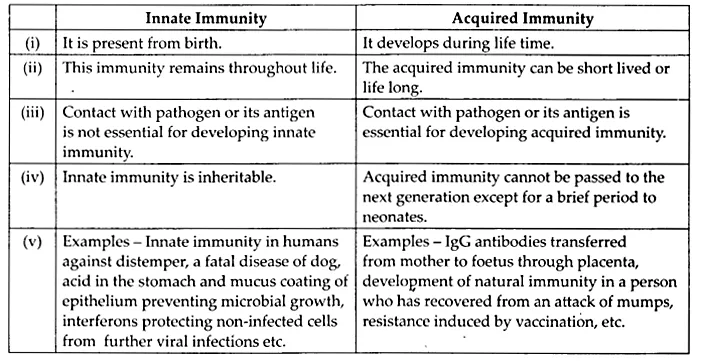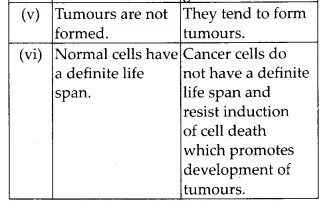NCERT Solutions for Class 12 Biology Chapter 8 Human Health and Diseases
These Solutions are part of NCERT Solutions for Class 12 Biology. Here we have given NCERT Solutions for Class 12 Biology Chapter 8 Human Health and Diseases
Question 1.
What are the various public health measures, which you would suggest as a safeguard against infectious diseases?
Solution:
Prevention and control of infectious diseases
I. For water-borne diseases like typhoid, amoebiasis, etc.
Practice personal and public hygienic measures.
a. Personal hygienic measures
- Keeping the body clean
- Consumption of clean drinking water
- Eating fresh food
b. Public hygienic measures
- Proper disposal of waste and excreta
- Periodic cleaning and disinfection of water reservoirs, pool, tank etc.
II. For air-borne diseases like common cold, pneumonia
- Avoid close contact with infected persons.
- Avoid the use of belongings of the infected persons.
III. For vector-borne diseases like malaria
- Control and eliminate the vectors and their breeding places
- Introducing larvivorous fishes like Gambusia in ponds that feed on the larvae of the mosquito
- Avoid stagnation of water around the residential area.
- Spraying of insecticides in ditches, drainage areas, etc.
- Protection from a mosquito bite. Use mosquito nets in the doors and windows to prevent the entry of mosquitoes. It is very important in the light of recently widespread diseases like dengue fever, chikungunya etc.
The use of vaccines and immunization programmes has enabled us to eradicate smallpox. Diseases like polio, diphtheria, tetanus etc. have been controlled to an extent by the use of vaccines. Nowadays biotechnology is focussing on the preparation of newer and safer vaccines. A large number of antibiotics are available to treat many infectious diseases.
Question 2.
In which way has the study of biology helped us to control infectious diseases?
Solution:
Study of biology has helped us to know about causes of diseases, carriers of diseases (vectors), effects of diseases on different body functions and above all, means to control diseases. Our immune system plays a major role in preventing diseases.
Question 3.
How does the transmission of each of the following diseases take place ?
- Amoebiasis
- Malaria
- Ascariasis
- Pneumonia
Solution:
- Through contaminated food and water.
- Through Anopheles mosquito.
- Through contaminated food and water.
- By inhaling the droplets or aerosols released by infected persons.
Question 4.
What measure would you take to prevent water-borne diseases?
Solution:
Water-borne diseases can be prevented by drinking clean water. Water should be free from contamination, suspended and dissolved substances. If water is contaminated it should be boiled and filtered before drinking. Periodic cleaning and disinfection of water reservoirs, pools, and tanks should be done.
Question 5.
Discuss with your teacher what does ‘a suitable gene’ means, in the context of DNA vaccines.
Solution:
‘A suitable gene’ means the gene which is able to produce antigenic polypeptides of the pathogen in bacteria and yeast. Using recombinant DNA technology, it is possible to produce vaccines in large scale for immunisation. Hepatitis B vaccine is produced using this technology.
Question 6.
Name the primary and secondary lymphoid organs.
Solution:
Primary lymphoid organs are bone marrow and thymus. Secondary lymphoid organs are the spleen, lymph nodes, tonsils, Peyer’s patches of the small intestine, and mucosa-associated lymphoid tissues (MALT).
Question 7.
The following are some well-known abbreviations, which have been used in this chapter. Expand each one to its full form.
- MALT
- CMI
- AIDS
- NACO
- HIV
Solution:
- MALT – Mucosal-associated lymphoid tissue.
- CMI – Cell-Mediated Immunity
- AIDS – Acquired Immuno Deficiency Syndrome
- NACO – National AIDS Control Organisation
- HIV – Human immunodeficiency virus.
Question 8.
Differentiate the following and give examples of each.
- Innate and acquired immunity,
- Active and passive immunity
Solution:
- : Differences between innate and acquired immunity are as follows:

- Differences between active and passive immunity are as follows:

Question 9.
Draw a well-labeled diagram of an antibody molecule.
Solution:

Question 10.
What are the various routes by which transmission of the human immunodeficiency virus takes place?
Solution:
Various routes of entry of ADDS virus are:
- Sexual contact with the infected person.
- Through placenta (from infected mother to foetus).
- Transfusion of infected blood or blood products.
- Sharing infected needles by drug abusers.
Question 11.
What is the mechanism by which the AIDS virus causes a deficiency of the immune system of the infected person?
Solution:
After getting into the body, the virus enters into the macrophages and converts its RNA genome into DNA with the help of a reverse transcriptase enzyme. The viral DNA takes and directs the infected cells to produce more virus particles i.e., the infected macrophages act like an HIV factory. Simultaneously, the HIV attack the T- lymphocytes and replicate and produce more viruses. Then they are released into the blood and attack other T-lymphocytes.
This will lead to a decrease in the number of T-lymphocytes and the patient begins to show the symptoms such as fever, diarrhea, weight loss etc. Subsequently, his immune system weakens and becomes more prone to infections of bacteria (like Mycobacterium), viruses, fungi and even parasites like Toxoplasma. Finally, he is unable to protect himself.
Question 12.
How is a cancerous cell different from a normal cell?
Solution:
Cancerous cell and normal cell are different in the following aspects:


Question 13.
Explain what is meant by metastasis.
Solution:
The rapid growth of cancerous tumour causes overcrowding and disruption of normal cells. It extends to neighbouring tissues. In the last stage, bits of tumour tissue break off and are carried by the circulating blood or lymphs to other parts of the body, where they invade new tissues and start new tumors called secondary tumors. This property is called metastasis. It is fated due to increasing interference with the body’s life processes.
Question 14.
List the harmful effects caused by alcohol/drug abuse.
Solution:
Harmful effects caused by alcohol/drug abuse are as follows:
- Among youth there is drop in academic performance, lack of interest in personal hygiene, isolation, depression, fatigue, aggressive and rebellious behavior, deteriorating relationships with family and friends, loss of interest in hobbies, change in sleeping and eating habits, fluctuations in weight, appetite, etc.
- Excessive dose of drugs leads to coma and death due to respiratory failure, heart failure or cerebral haemorrhage.
- Abusers become mental and cause financial distress to their entire family and friends.
- They may acquire serious infections like AIDS and hepatitis by taking drugs intravenously.
- Intake of alcohol/drugs damages nervous system, liver (cirrhosis) and kidney.
- Drug abuse adversely affects foetus in case of pregnancy, leading to Foetal Alcohol Syndrome (FAS).
- Continuous use of narcotics and stimulants cause impotency and chromosomal aberrations.
- Heavy drinking can cause an acute alcoholic myopathy characterised by painful and swollen muscles and high levels of serum creatine phosphokinase (CK). Chronic alcoholic men may show testicular atrophy with shrinkage of the seminiferous tubules and loss of sperm cells.
- Heavy drinking causes acute and chronic pancreatitis.
- Alcohol increases RBC size causing a mild anemia.
- Legal problems occur, such as arrest by police for obtaining and keeping drugs unlawfully.
Question 15.
Do you think that friends can influence one to take alcohol/drugs? If yes, how can one protect himself/herself from such an influence?
Solution:
Yes. This can be avoided by
- Choosing a good peer group.
- Discussing ways and means to counteract the presence if any with family elders and teacher/counselors
- Telling the program of an outing to family.
- Keeping contact with family while outside the home.
Question 16.
Why is it that once a person starts taking alcohol or drugs, it is difficult to get rid of this habit? Discuss it with your teacher.
Solution:
Once a person starts taking alcohol or drugs, it is difficult to get rid of this habit because he becomes addicted to it. Addiction is a psychological attachment to certain effects such as euphoria and a temporary feeling of well-being. These drive people to consume drugs/alcohol even when these are not needed, or even when their use becomes self-destructive. With repeated use, the tolerance level of the receptors present in the body increases, which consequently leads to a higher dose of drugs/alcohol and addiction.
Thus, the addictive potential of drugs and alcohol pull the user into a vicious circle leading to their regular use from which he/she may not be able to get out.
Question 17.
In your view what motivates youngsters to take alcohol or drugs and how can this be avoided?
Solution:
There are many factors that motivate youngsters to take alcohol or drug. These include:
- Choosing a good peer group.
- Discussing ways and means to counteract the presence if any with family elders and teacher/counselors
- Telling the programme of an outing to family.
- Keeping contact with family while outside the home.
This can be avoided by the following measures:
- Education and counseling: Educating and counseling people to face problems and stresses, and to accept disappointments and failures as a part of life.
- Seeking help from parents and peers: Help from parents and peers should be sought immediately so that they can guide appropriately. Help may even be sought from close and trusted friends.
- Looking for danger signs: Alert parents and teachers to look for and identify the danger signs. Even friends, if they find someone using drugs or alcohol, should not hesitate to bring this to the notice of parents or teachers in the best interests of the person concerned.
- Seeking professional and medical help: Lots of help is available in the form of highly qualified psychologists, psychiatrists, and de-addiction and rehabilitation programmes to help individuals who have unfortunately got in the quagmire of drug/alcohol abuse.
- Cross-checking before prescribing and selling drugs: The physicians should prescribe the habituating drugs only to genuine persons and only for the essential duration. Pharmacists should not sell these drugs without the physician’s prescription.
- Discipline: Good nurturance with consistent discipline but without suffocating strictness reduces the risk of addictions.
- Communication: The child must be able to communicate with the parents seeking clarification of all doubts and discussing problems that arise in studies or develop in the class, with friends, siblings and others.
- Appreciation: For even the smallest achievement, good behavior and other activities, the child should be appreciated.
- Independent working: Giving responsibility to the child for small tasks and allowing him/her to perform independently. However, guidance should be provided where required.
- Avoid undue pressure: Every child has a specific personality with certain preferences and choices. They should be taken care of and respected. No child should be asked to perform beyond threshold limits whether in studies, sports or extracurricular activities.
We hope the NCERT Solutions for Class 12 Biology Chapter 8 Human Health and Diseases help you. If you have any query regarding NCERT Solutions for Class 12 Biology Chapter 8 Human Health and Diseases, drop a comment below and we will get back to you at the earliest.